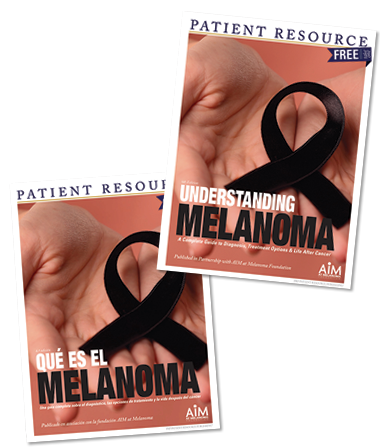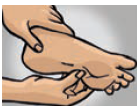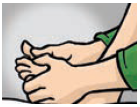
Melanoma
For Your Friends and Family
Now that you have experienced a melanoma diagnosis, consider joining the many other survivors who advocate for melanoma awareness. It doesn’t take a grand gesture. By simply talking about ways to lower the risks and how to screen, you may contribute to a better outcome for your friends and family members. Moving forward begins with being educated about melanoma.
Know the Risks
It’s hard for many to believe that the sun can be so dangerous, but it is. It is the main source of ultraviolet (UV) rays, and it is crucial for all of us to avoid excessive exposure.
However, melanoma doesn’t just develop on skin that is exposed to the sun. It can develop in the mucosal lining of the body, a membrane covering many body cavities and passageways. The body’s moist mucosal linings are in the respiratory tract; sinuses, nasal passages and mouth; gastrointestinal tract, including the anus and rectum; and female genital tract, including the vagina and vulva.
Melanoma and other skin cancers may run in families, so encourage your family members to pay special attention to the following.
Who Needs Sunscreen?
That’s easy. Everyone. A common misconception is that only people with fair skin need to wear sunscreen. Although it is particularly important for people with a fair complexion, light-colored eyes, blonde or red hair and a tendency to burn or freckle with exposure to the sun, all people regardless of skin color are at risk.
Although darker skin has more melanin (the pigment that gives skin its color), which offers some protection from harmful UV rays, it is still vulnerable and sunscreen should be worn. Research shows that when people with dark skin are diagnosed with melanoma, it is often at a later stage because many people simply aren’t aware that they are at risk. If you have dark skin and are aware of the risk but don’t like the white residue sunscreen leaves on your skin, you’re in luck. Different tints are now available for different skin tones, which helps avoid that filmy residue after each application.
To get the benefit of sunscreen, you must use it correctly.
- Choose a sunscreen with an SPF of at least 15 to 30. A higher SPF may be necessary to avoid burning.
- Look for “blocks UVA and UVB” or “broad spectrum” on the label.
- Use sunscreen anytime you plan to be in the sun for more than 20 minutes, even when it’s cloudy.
- Apply liberally (minimum of 1 ounce, about the same amount as in a shot glass) at least 30 minutes before sun exposure. If you use spray sunscreen, be sure to cover all exposed skin.
- Also apply to your ears, scalp, lips, neck, tops of feet and backs of hands.
- Reapply at least every 2 hours and each time you get out of the water or sweat heavily.
- Apply underneath your makeup and lip balm, even if they already contain SPF.
- Apply sunscreen first and bug spray second. Sunscreen may need to be reapplied more often.
- Sunscreen expires! Throw it away after 1 to 2 years to ensure what you’re using is effective.
- Use sunscreen in all seasons, even when it is cloudy. Snow reflects up to 80 percent of the sun’s rays.
- Avoid indoor tanning, and do not use sun exposure to increase your levels of vitamin D. To be sure you get enough vitamin D, your doctor may check your blood levels and may suggest an oral supplement.
- Ask your dermatologist for sunscreen recommendations if you have allergies or skin conditions.
Remember, wearing suncreen does not mean you should spend more time in the sun. And, don’t rely on the sun to increase your vitamin D levels. To ensure you get enough vitamin D, your doctor may check your blood levels and may suggest an oral supplement.
Sunburn is just one risk to keep in mind. Some medicines can make your skin more sensitive to the sun, which may increase your risk of melanoma. Lesser-known risks include certain medical conditions, scars, skin conditions, skin ulcers and a high level of exposure to arsenic.
Self-Exams are a Must Especially with Tattoos
Early detection may be key to a better outcome from a melanoma diagnosis. It takes very little effort on your part. All you have to do is look at your skin. For those hard-to-see places, ask a loved one or a dermatologist for their help. If anything looks out of the ordinary, contact your doctor. It sounds simple enough, but it’s not always easy to tell if something doesn’t look right. To help you identify an abnormal mole or spot.
If your skin has certain characteristics, such as dark pigment, scars, constantly irritated areas or tattoos, you should be extra diligent about performing self-exams because these can make it more difficult to detect a mole or spot that doesn’t look right.
For this reason, tattoo artists tend to avoid inking over existing moles or problem areas. However, that isn’t always possible. Some tattoos are elaborate in color and size, such as a sleeve, which is a tattoo that runs from your wrist to your shoulder and often incorporates multiple colors.
If you have one or more tattoos or areas that may easily hide an irregularity, be sure to perform regular self-exams and see a dermatologist for preventive checks.
Self-Exams
To conduct a thorough self-exam, use a mirror to examine these key checkpoints: neck, chest, torso, arms, legs, groin and face, including the skin around your eyes, ears and inside your nose and mouth. Don’t forget these often overlooked areas:
 Scalp
Scalp Soles of Feet
Soles of Feet Between the toes
Between the toes Back / between buttocks
Back / between buttocks Underarms
Underarms

